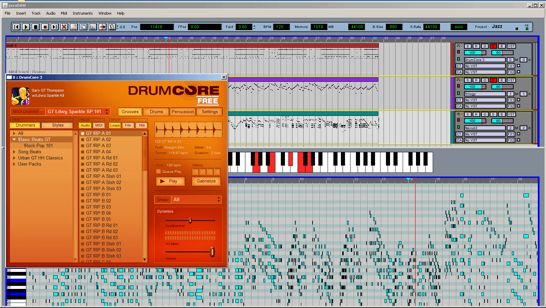
MIDIWorks has released version 1.2 of javaDAW – a Java Sequencer for playing and manipulating MIDI files.
javaDAW is completely build in Java and uses the VST plugin and ASIO solutions of Martin Roth.
Description:
In javaDAW you may create MIDI clips and add midi notes to each clip with a (double) click of your mouse. Insert a Midi track, assign a VST Plugin to a track (F3) and hit the play button (space bar) after insert a midi file of course. You can also create and import audio clips.
javaDAW Features:
- Using ASIO or Java Sound.
- Importing and exporting (multiple) MIDI files.
- Importing and exporting .wav files.
- Drag and drop functionality for these files directly form the Desktop.
- Manipulate clips and MIDI notes (delete, copy, etc…..)
- Quantisize MIDI notes and clips(F5 & F6).
- Add and connect MIDI controllers to javaDAW.
- Recording directly form your MIDI controller.
- Quantisize MIDI notes when recording.
- Scale up and down when in the clip of midi edit area(CNTRL left/right arrow).
- Add, copy and remove MIDI and Audio tracks(F7).
- Play and hit the follow button.
- Use automation on volume and modulation (midi messages).
- Use (S)tep mode to learn a piano piece.
- Follow a score presentation of your MIDI file.
- Use the step sequencer and MIDI keyboard to learn a piece.
- Change VST plugins whenever you like.
- Add FX VST plugins whenever you like.
- Add and adjust automation per track for volume and modulation.
- Adjust the edit areas for the note and clip editing.
- Save and read project files.
- Add pattern files for drum, base and organ directly into your project.
- Export an AUDIO file in .wav format.
- Import an AUDIO file in .wav format (16 bit).
- Record an AUDIO signal from microphone or keyboard.
- Add a MIDI channel or an AUDIO channel.
In this release (1.2) several bugs are solved:
- Recording wav file is now put in the project wav directory instead of resource directory.
- JavaDAW had a problem starting up when no ASIO driver is available. Starts up with default java audio engine.
- Deleting audio clips ended up in a mess.
- Step mode added as a function key (S key).
- Disable control panel added (F8 key).
- Has been tested under Windows 7 now (XP performs better).
- Adjusts the application size to smaller screens.
javaDAW’s features will be explained in the online manual. T.b.d.

I've been programming in Java for years, its actually one of my favorite languages. Though many people either get confused by it (its a 2-faced phenomenon. At one side its a programming language, at the other its a platform which allows you to run the programs) or simply consider it "too simple" (probably because its also being used in many schools to teach the principals of programming). In my opinion those guys fall under the same category who take a peek at Live and consider it "not a real DAW", purely due to its "plain" interface.
Alas.. Refreshing to see that Java has some roots in the world of multimedia as well. I'm well aware that Java has options for graphics and sounds, but never really looked into it deeply. And I didn't know about the libraries allowing you to access ASIO and vst type calls, impressive!
Just goes to show you that even though its age and very strict rules with regards to expansion (Java is commonly backwards compatible. In other words; a program written with Java 1 will still work with the current version, even though its almost 15 years old) Java is very flexible where it counts.
Well, I guess its not a coincidence that one of the supported external languages for Cycling '74's Max/MSP is Java.
I've been programming in Java for years, its actually one of my favorite languages. Though many people either get confused by it (its a 2-faced phenomenon. At one side its a programming language, at the other its a platform which allows you to run the programs) or simply consider it "too simple" (probably because its also being used in many schools to teach the principals of programming). In my opinion those guys fall under the same category who take a peek at Live and consider it "not a real DAW", purely due to its "plain" interface.
Alas.. Refreshing to see that Java has some roots in the world of multimedia as well. I'm well aware that Java has options for graphics and sounds, but never really looked into it deeply. And I didn't know about the libraries allowing you to access ASIO and vst type calls, impressive!
Just goes to show you that even though its age and very strict rules with regards to expansion (Java is commonly backwards compatible. In other words; a program written with Java 1 will still work with the current version, even though its almost 15 years old) Java is very flexible where it counts.
Well, I guess its not a coincidence that one of the supported external languages for Cycling '74's Max/MSP is Java.